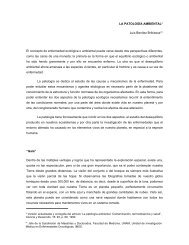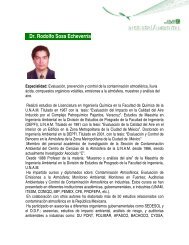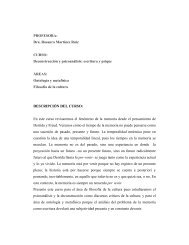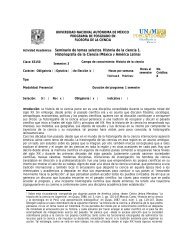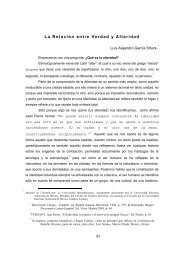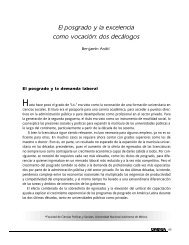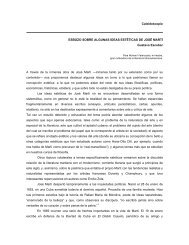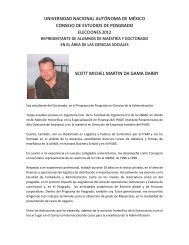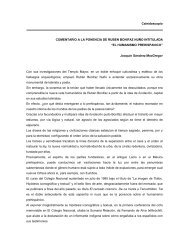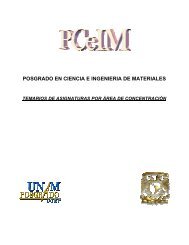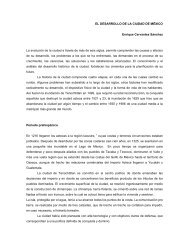Review: Resisting the Ninth Author(s): Richard Taruskin Reviewed ...
Review: Resisting the Ninth Author(s): Richard Taruskin Reviewed ...
Review: Resisting the Ninth Author(s): Richard Taruskin Reviewed ...
You also want an ePaper? Increase the reach of your titles
YUMPU automatically turns print PDFs into web optimized ePapers that Google loves.
sesses a mysterious and self-contained character<br />
that stands in opposition to <strong>the</strong> world of<br />
every day experience, " so that <strong>the</strong> beginning of a<br />
composition is like "<strong>the</strong> unveiling of a secret<br />
domain."<br />
Norrington, with his passion for clarity and<br />
his genius for vivid articulation, plays this gambit<br />
utterly false and frustrates its magical effect.<br />
The tremolo in second violin and cello, notated<br />
as a sextolet, is articulated like a nervous little<br />
tarantella with six eminently countable sixteenths<br />
to <strong>the</strong> bar and an accent on every downbeat:<br />
DIG-a-da-dig-a-da DIG-a-da-dig-a-da. The<br />
quality of time is kinetic, not hovering. With<br />
<strong>the</strong> beats and measures so highly organized, and<br />
<strong>the</strong> tempo so regular, <strong>the</strong> gradual coalescing of<br />
<strong>the</strong> <strong>the</strong>me proceeds like clockwork, or like an<br />
advancing army. The metrical displacement of<br />
<strong>the</strong> entries as <strong>the</strong> passage moves to its culmination-surely<br />
intended to maintain vagueness<br />
and prevent kinetic regularity from ever setting<br />
in-emerges as precise syncopations. No secret<br />
domain gets unveiled. Great success in realizing<br />
<strong>the</strong> letter of <strong>the</strong> score here has led to a falsification<br />
of its spirit.' No one would glean from<br />
<strong>the</strong> opening of this performance <strong>the</strong> intimations<br />
of <strong>the</strong> cosmic and <strong>the</strong> infinite to which<br />
Nietzsche gave expression in a passage from<br />
Human, All Too Human-"The thinker feels<br />
himself floating above <strong>the</strong> earth in an astral<br />
dome, with <strong>the</strong> dream of immortality in his<br />
heart: all <strong>the</strong> stars seem to glimmer about him,<br />
and <strong>the</strong> earth seems to sink ever fur<strong>the</strong>r downward"-an<br />
impression that links up presciently<br />
with that o<strong>the</strong>r tremolando-ridden passage in<br />
<strong>the</strong> finale when God's dwelling place "beyond<br />
<strong>the</strong> stars" is invoked. Here again, vagueness is<br />
assured by <strong>the</strong> vertical superimposition of quarter-note<br />
triplets in <strong>the</strong> winds against sixteenths<br />
in <strong>the</strong> strings. And this passage, in turn, is <strong>the</strong><br />
'It could be argued, of course, that Beethoven's notation is<br />
exact, and <strong>the</strong> claim of vagueness is based on a preconception.<br />
The sort of "spirit" I am looking for, one could contend,<br />
demands a different sort of notation, i.e., an "unmeasured"<br />
tremolo. The latter, though, seems not to have been a<br />
part of Beethoven's notational vocabulary. The earliest<br />
symphonic score in which I have spotted it is Berlioz's Symphonie<br />
fantastique of 1830, though Adam Carse, in his History<br />
of Orchestration, cites operatic precedents going back<br />
to <strong>the</strong> eighteenth century. Beethoven's use of <strong>the</strong> sextolet,<br />
contradicting <strong>the</strong> subdivisions at <strong>the</strong> melodic surface,<br />
would seem to be evidence that Beethoven's intended effect<br />
was <strong>the</strong> very blur that Norrington has triumphantly clarified.<br />
very one that resonates with Beethoven's reading<br />
of Kant, whom he perceived as equating<br />
"<strong>the</strong> moral law within us, and <strong>the</strong> starry heavens<br />
above us."<br />
A reading of <strong>the</strong> <strong>Ninth</strong> as a pack of notes,<br />
even an inspired reading of <strong>the</strong> notes like Norrington's,<br />
leaves us very far from <strong>the</strong> truth of <strong>the</strong><br />
work, for all that our knowledge of <strong>the</strong> latter is<br />
doomed to incompleteness. Illuminating readings<br />
of <strong>the</strong> score-and here I must place Furtwangler's<br />
in a class of its own-are those which<br />
make <strong>the</strong> kind of connections discussed in <strong>the</strong><br />
last paragraph. It is that kind of performance,<br />
which may be achieved with any instruments<br />
using any tempos, that truly counts as an interpretation,<br />
in <strong>the</strong> hermeneutic sense.<br />
Though full of surface distortions, Furtwangler's<br />
performance makes disclosure after<br />
spinetingling disclosure of <strong>the</strong> spiritual content<br />
of <strong>the</strong> music by means of inspirational, unnotated<br />
emphases, pointing to unsuspected musical<br />
parallels that link widely dispersed passages. It<br />
was not until I heard Furtwangler's unnotated<br />
tenutos in m. 24 of <strong>the</strong> first movement, and his<br />
unnotated molto ritardandos two bars later,<br />
that I realized <strong>the</strong> significance of <strong>the</strong> enigmatic<br />
Eb-major chord (a "Neapolitan," but in root position,<br />
not <strong>the</strong> conventional "sixth"), which<br />
moves to a diminished-seventh chord on E~ in<br />
m. 27. These are <strong>the</strong> precise harmonies that, in<br />
<strong>the</strong> last movement, introduce Beethoven's depiction<br />
of <strong>the</strong> "starry dome" beyond which God<br />
makes his abode, <strong>the</strong> "denouement of <strong>the</strong> entire<br />
symphony," to quote Treitler. It is <strong>the</strong> chord<br />
progression that, with <strong>the</strong> addition of A in <strong>the</strong><br />
bass, leads finally and securely to <strong>the</strong> neveragain-to-be-questioned<br />
D major of Elysium, <strong>the</strong><br />
very progression <strong>the</strong> first movement never gets<br />
to consummate. It is <strong>the</strong> progression <strong>the</strong> timpani<br />
tries so hard to insist upon at <strong>the</strong> first<br />
movement recapitulation, but can never browbeat<br />
<strong>the</strong> bass instruments into vouchsafing:<br />
<strong>the</strong>ir unstable F# falls inexorably to F~, and Elysium<br />
is lost. (At mm. 326-27, timpani still raging,<br />
<strong>the</strong> "beyond <strong>the</strong> stars" progression is assayed<br />
once more, but again to no avail; D major<br />
again fails to materialize.)<br />
Again, it was thanks to Furtwdngler-who<br />
with courageous initiative decided that <strong>the</strong> fortissimo<br />
for <strong>the</strong> brass's F at m. 132 in <strong>the</strong> Adagio<br />
should also apply to <strong>the</strong> low strings' D6 a bar<br />
later-that I was able, to my astonishment, to<br />
251<br />
PERFORMERS &<br />
INSTRUMENTS



